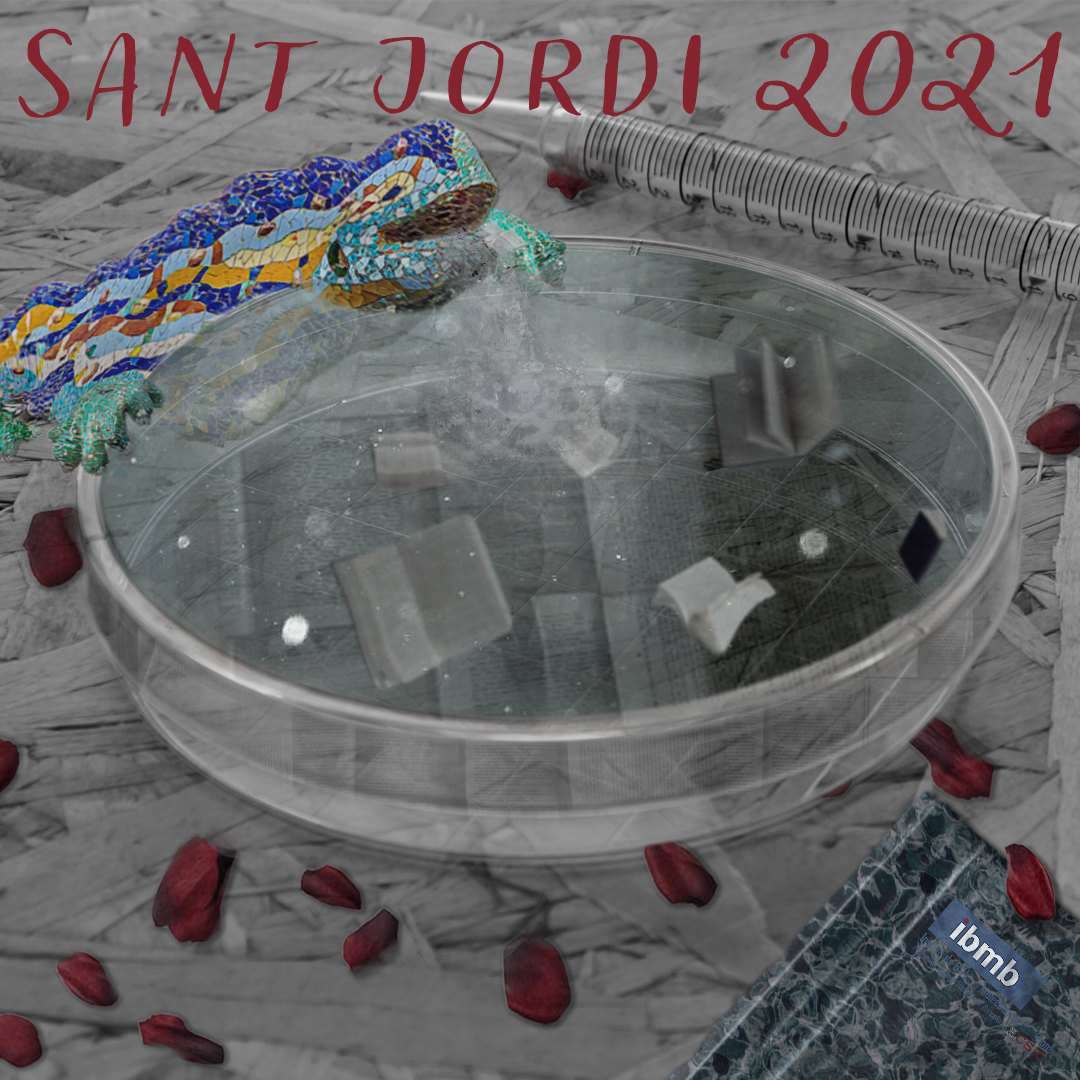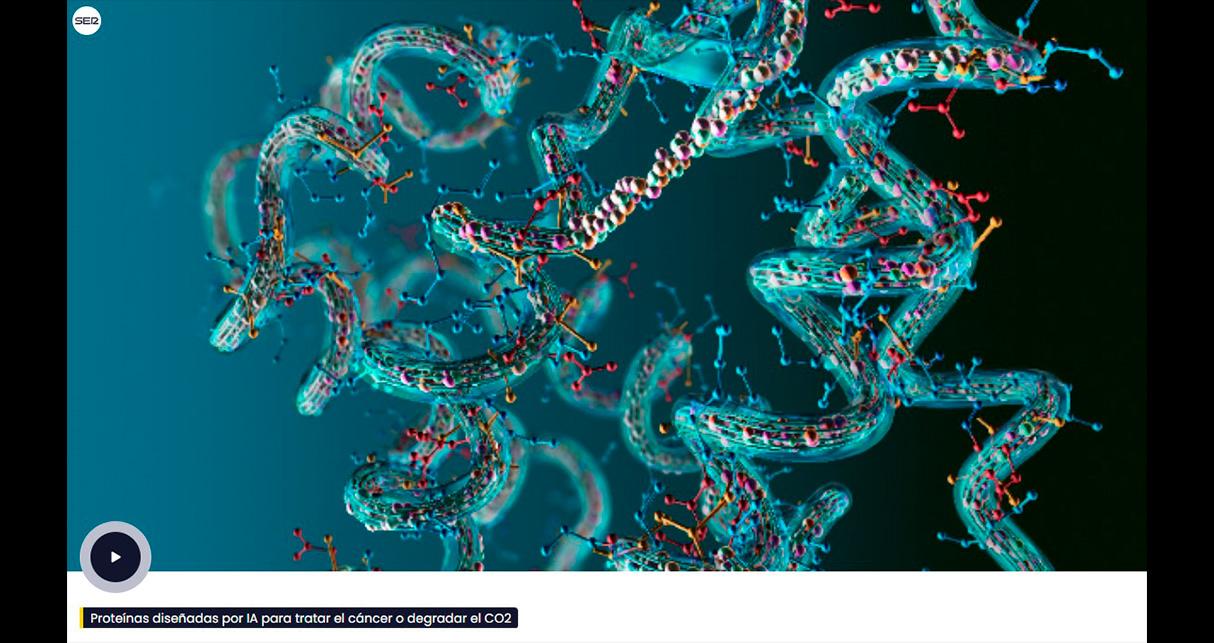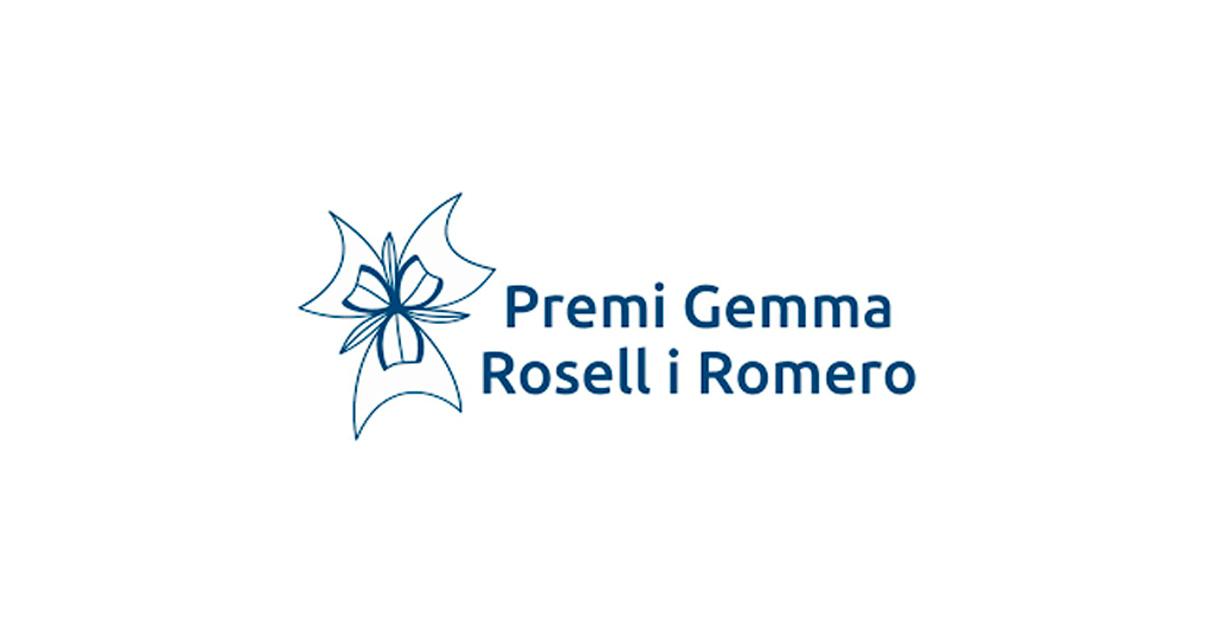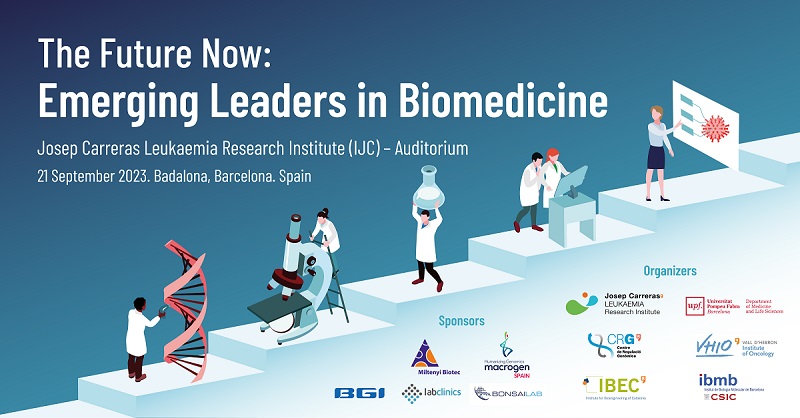Noelia Ferruz was interviewed on Cadena Ser to talk about proteins designed using AI.
Set of activities carried out by the members of the IBMB on the occasion of April 23: Sant Jordi
2021 | April 23, Set of activities carried out by the members of the IBMB on the occasion of April 23: Sant Jordi.
TALKS
-
- Participation of the IBMB researchers, Jordi Casanova, writer of the book Petita història dels humans, and Joana Segura, writer of the book Lynn Margulis. La bióloga que descubrió el origen de nuestras células, in the talk organized within the framework of Inspiraciencia, Science and Literature, on April 28.
VIDEO
5 interviews with IBMB researchers in which they tell us about the relationship they make between literature and science and give us some literary recommendation. You can find them in the following playlist.
PICTURES
Composition made on the occasion of Sant Jordi.
The image represents the Drac of Park Güell leaning on a petri dish in which he functions as a source of water and books. An attempt is made to make a relationship between the representative elements of Sant Jordi’s day (dragon, roses, books …) and science, represented by the pipette and the petri dish.
WRITTEN RECOMMENDATIONS
Joan Roig’s recommendations
CAT | Al nostre grup estudiem les xarxes de comunicació de la cèl·lula, així que alguna de les meves recomanacions serà també de xarxes i comunicacions. I viatges, ara que estem tots confinats.
The Songlines, del Bruce Chatwin, traduït al castellà com Los trazos de la canción (Península), un fabulós i estrany llibre de l’autor de In Patagonia. Viatges, cites, personatges i les xarxes de camins-cançons dels aborígens australians, una manera diferent a la nostra de veure (i construir, i cantar) el món.
Verd Aigua de la Marisa Madieri (en català i castellà a Minúscula). Viatges obligats, en el temps i l’espai. La infància de l’escriptora, refugiada a Trieste després de que la seva ciutat, Fiume, passés a Croàcia a la fi de la segona guerra mundial.
Todo eso que tanto nos gusta (Pedro Zarraluki, a Destino). El pare que s’escapa al Tíbet -i no arriba més enllà de l’Empordà. A partir d’aquí personatges i les seves relacions i la vida. I les seves coses.
El Arte de Perder, Alice Zeniter (traduit al castellà a Salamandra). Les xarxes de la família i la història. D’Algèria, un país amb un passat recent que ha marcat a vàries generacions. Com diu la contraportada “una novela arrebatadora sobre los orígenes, la identidad y la libertad de ser uno mismo”.
I finalment, un sobre ciència. O millor sobre els models que ens permeten fer-la: A Guinea Pig’s History of Biology del Jim Endersby (traduit al castellà a Ariel: Una historia de la biología según el conejillo de Indias). Perquè qui no vol llegir un llibre amb un capítol titulat “Drosphila melanogaster. Bananas, bottles and Bolsheviks”?
Biographical book recommendations Elisa Martí
Rosalind Franklin: The Dark Lady of DNA by Brenda Maddox
This is the extraordinarily powerful story of Rosalind Franklin, told by one of our greatest biographers; the single-minded young scientist whose contribution to arguably the most significant discovery of all time went unrecognised, elbowed aside in the rush for glory, and who died too young to recover her claim to some of that reputation, a woman who was not the wife of anybody and who is a myth in the making. Like a medieval saint, Franklin looms larger as she recedes in time. She has become a feminist icon, the Sylvia Plath of molecular biology. This will be a full and balanced biography, that will examine Franklin’s abruptness and tempestuousness, her loneliness and her relationships, the powerful family from which she sprang and the uniqueness of the work in which she was engaged. It is a vivid portrait, in sum, of a gifted young woman drawn against a background of women’s education, Anglo-Jewry and the greatest scientific discovery of the century.
In Praise Of Imperfection by Rita Levi-Montalcini
The autobiography of Levi-Montalcini, who won the Nobel Prize for Medicine in 1986. Born in Torino into a middle-class Jewish family, she experienced the rise of fascism and antisemitism in the 1930s-40s (discussed on pp. 73-105). After the promulgation of the racial laws in 1938, it was impossible for her to pursue research at the Neurological Clinic and she continued her work in private. She survived the war hiding in a small town in Italy and later emigrated to the United States.
Rise of the Rocket Girls: The Women Who Propelled Us, from Missiles to the Moon to Mars by Nathalia Holt
In the 1940s and 50s, when the newly minted Jet Propulsion Laboratory needed quick-thinking mathematicians to calculate velocities and plot trajectories, they recruited an elite group of young women who, with only pencil, paper, and mathematical prowess, transformed rocket design, helped bring about the first American satellites, and made the exploration of the solar system possible. Rise of the Rocket Girls tells the stories of these women–known as “human computers”–who broke the boundaries of both gender and science. Based on extensive research and interviews, Nathalia Holt offers a unique perspective on the role of women in science: both where we’ve been, and the far reaches of space to which we’re heading.
Silent Spring by Rachel Carson
A handsome anniversary edition of the classic environmental study discusses the reckless annihilation of fish and birds by the use of pesticides and warns of the possible genetic effects on humans, in a volume that incorporates new essays by activist Terry Tempest Williams and Carson biographer Linda Lear.
What Stars Are Made Of: The Life of Cecilia Payne-Gaposchkin by Donovan Moore
It was not easy being a woman of ambition in early twentieth-century England, much less one who wished to be a scientist. Cecilia Payne-Gaposchkin overcame prodigious obstacles to become a woman of many firsts: the first to receive a PhD in astronomy from Radcliffe College, the first promoted to full professor at Harvard, the first to head a department there. And, in what has been called “the most brilliant PhD thesis ever written in astronomy,” she was the first to describe what stars are made of.
In What Stars Are Made Of, Donovan Moore brings this remarkable woman to life through extensive archival research, family interviews, and photographs. Moore retraces Payne-Gaposchkin’s steps with visits to cramped observatories and nighttime bicycle rides through the streets of Cambridge, England. The result is a story of devotion and tenacity that speaks powerfully to our own time.
Dorothy Crowfoot Hodgkin: Patterns, Proteins and Peace: A Life in Science by Georgina Ferry
Dorothy Crowfoot Hodgkin (1910-1994) was passionate in her quest to understand the molecules of the living body. She won the Nobel Prize for Chemistry in 1964 for her work on penicillin and Vitamin B12, and her study of insulin made her a pioneer in protein crystallography. Fully engaged with the political and social currents of her time, Hodgkin experienced a radical change in women’s education, the globalisation of science, relationships between East and West, and international initiatives for peace.
Georgina Ferry’s definitive biography of Britain’s first female Nobel prizewinning scientist was shortlisted for the Duff Cooper Prize and the Marsh Biography Award. This revised and updated edition includes a new preface from the author.
Blazing the Trail: Essays by Leading Women in Science by Emma Ideal
Name a famous scientist. Got one? Now name a famous physicist. Ok, now name a famous female physicist. Ok, now name a famous living female physicist. Stumped? In Blazing the Trail: Essays by Leading Women in Science, 35 highly successful physicists, engineers, and chemists share their personal histories, their passion for discovery, and their secrets for success with the next generation. Essayists candidly recount their experiences – both positive and negative – with an uplifting tone, focusing on lessons learned along the way. The combination of personal stories and advice sends a powerful message to all young women considering scientific careers: I did it, so can you. Here’s how.
Recommendations of Jordi Bernués
What is life? by Paul Nurse (Nobel Prize) from GeoPlaneta (2020) in the scientific field.
In general literature “Ignot” by Manuel Baixaulí (Edicions del Periscopi) and “Sortir a robar cavalls” by Per Petterson (Club Editor).
Recommendations Guillermo Pablo Vicent
Paul de Kruif’s (1926) classic book “Microbe Hunters” and the other, “Serendipia. Accidental Discoveries in Science” by Royston M Roberts (1992). Adrian Paenza’s book Mathematics … are you there? and the series of books of Diego Golombek:
ES|
- Golombek, Diego (2006). Sexo, drogas y biología. (Y un poco de rock and roll) (in Spanish). Buenos Aires: Siglo Veintuno. ISBN 978-987-1220-
70-0. - Golombek, Diego (comp.) (2007). ADN: cincuenta años no es nada (in Spanish). Buenos Aires: Siglo Veintuno. ISBN 978-987-629-
012-8. - Golombek, Diego (2011). Cavernas y palacios. En busca de la conciencia en el cerebro (in Spanish). Buenos Aires: Siglo Veintuno. ISBN 978-987-629-
193-4. - Golombek, Diego (2012). Demoliendo papers. La trastienda de las publicaciones científicas (in Spanish). Buenos Aires: Siglo Veintuno. ISBN 978-987-629-
227-6. - Golombek, Diego (2012). El nuevo cocinero científico. Cuando la ciencia se mete en la cocina (in Spanish). Buenos Aires: Siglo Veintuno. ISBN 978-987-629-
244-3. - Golombek, Diego (2014). Las neuronas de Dios. Una neurociencia de la religión, la espiritualidad y la luz al final del túnel (in Spanish). Buenos Aires: Siglo Veintuno. ISBN 978-987-629-
479-9.




